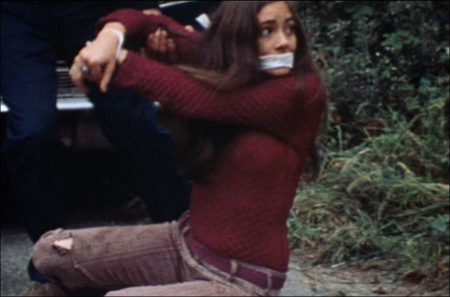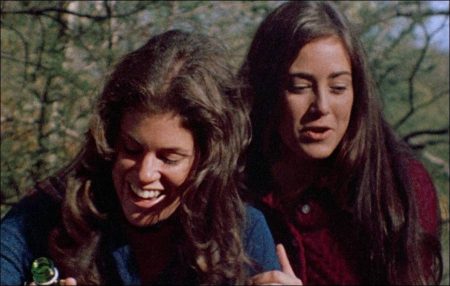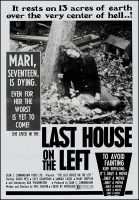Taglines: It’s just across the street from “Joe”.
The Last House on the Left movie storyline. On the eve of her seventeenth birthday, Mari Collingwood tells her parents that she is going to the concert of underground band Bloodlust in New York with her friend Phyllis Stone. She borrows the family’s car and heads with her friend to a dangerous neighborhood in the city.
Meanwhile, the sadistic and cruel escapees Krug Stillo and Fred ‘Weasel’ Podowski are hidden in a hideout with their partners Sadie (Jeramie Rain) and Krug’s addicted son Junior Stillo (Marc Sheffler) after killing two guards and one shepherd in their runaway. The two girls seek marijuana near the theater and meet Junior that offers some Colombian grass to them. They go to his apartment and are subdued by the criminals that rape Phyllis. On the next morning, they hide the girls in the trunk of their convertible and head to Canada.

However, they have a problem with the car’s rod and they stop on the road close to Mari’s house. When Phyllis tries to escape, the gang stabs her to death and shots Mari after humiliating and raping them. They seek shelter in Mari’s home, but during the night, her mother overhears a conversation of the criminals telling that they have killed her daughter. She tells her husband and they plot a scheme to revenge the death of their princess.
The Last House on the Left is a 1972 American exploitation horror film written, edited, and directed by Wes Craven and produced by Sean S. Cunningham. The film stars Sandra Peabody, Lucy Grantham, David A. Hess, Fred Lincoln, Jeramie Rain, and Marc Sheffler. The plot revolves around two teenage girls who are taken into the woods and tortured by a gang of murderous thugs. The story is inspired by the Swedish film The Virgin Spring (1960), directed by Ingmar Bergman, which in turn is based on a Swedish ballad, “Töres döttrar i Wänge”.
Craven’s directorial debut, the film was made on a modest budget of $87,000, and was filmed in New York City and rural Connecticut in 1971. It was released theatrically in the United States on August 30, 1972, and was a major box office success, grossing over $3 million domestically. Although its confrontational violence resulted in it being heavily censored and sometimes banned in other countries, the film was generally well received by critics. It was remade under the same title in 2009.
About the Filming
The film was shot on location for seven days in New York City, as well as Long Island, followed by shoots in rural locations outside of Westport, Connecticut. While filming in Connecticut, the cast and crew spent much time at producer Cunningham’s family’s home. According to Craven, the lake sequence was shot in the town reservoir of Weston, Connecticut. Craven sought a “documentary”-style appearance for the film, marked by close-up shots and single-cut takes.
Cunningham later described the film shoot as being “guerrilla-style” with the crew spontaneously filming at locations and being forced to leave due to lack of permits; in retrospect, Lincoln said that “nobody knew what [they] were doing.” Much of the special effects in the film were achieved practically, some at Lincoln’s suggestion: For example, the sequence in which Phyllis is disemboweled, Lincoln helped craft fake intestines with condoms filled with fake blood and sand.
For the murder sequence of Sadie in the swimming pool, Rain had a pouch full of fake blood attached underneath her shirt as well as blood capsules in her mouth, which she manually punctured. Grantham recalled during the scene in which Hess’s character tells her to “piss her pants,” that she in fact urinated in her jeans. Steve Miner, who would later become a director himself, served as a production assistant on the film.
Hess recalled that much of the cast bonded heavily during the filming process being that they were mostly inexperienced actors. Lincoln, Rain, and Sheffler recalled similar memories in a 2003 documentary titled Celluloid Crime of the Century, which recounted the making of the film. However, both Hess and director Craven recalled the on-set relationship between Hess and Peabody to be turbulent. Peabody was often treated differently than the rest of the cast to the point that Craven recalled there “not being much acting” during the shooting of the film’s more violent scenes. Sheffler admitted during a one-on-one sequence with Peabody that he threatened to push her over a cliff if she failed to hit her marks.
Peabody stated that she was genuinely upset during the filming of the more violent scenes as she felt unprepared: “I was upset because I’m an emotional person, and I reacted to what was going on as if it were real. I had a really hard time with some of scenes, because I had come out of American Playhouse, where it was all about preparation, and everything had to be real.
I ended up doing a horrible job in the film. I was very upset, and I felt like I should have channeled that, but I couldn’t… I was a young actress and I was still learning to balance any emotions I had from outside of the film into my scene work.” Hess revealed that he actually got very physical with her during the filming of the rape scene and that she couldn’t do anything about it once the camera was running.
The Last House on the Left (1972)
Directed by: Wes Craven
Starring: Sandra Peabody, Lucy Grantham, David A. Hess, Fred Lincoln, Jeramie Rain, Marc Sheffler, Cynthia Carr, Ada Washington, Marshall Anker, Martin Kove, Ray Edwards
Screenplay by: Wes Craven
Production Design by:
Cinematography by: Victor Hurwitz
Film Editing by: Wes Craven
Costume Design by: Susan E. Cunningham
Makeup Department: Anne Paul
Music by: David Alexander Hess
MPAA Rating: None.
Distributed by: Hallmark Releasing, American International Pictures
Release Date: August 30, 1972
Views: 450


